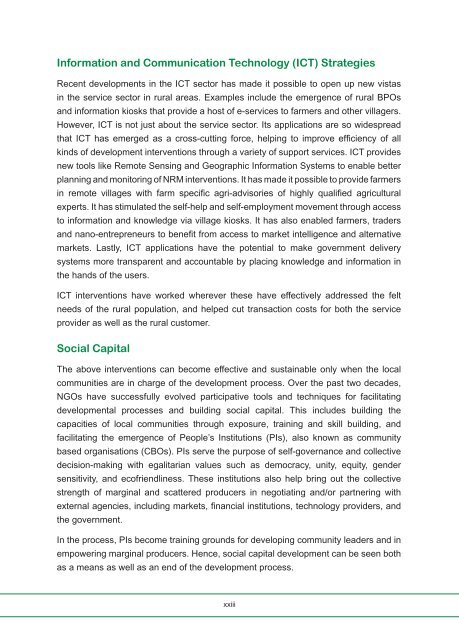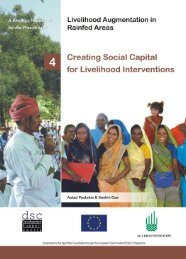Livelihood Augmentation in Rainfed Areas - Development Support ...
Livelihood Augmentation in Rainfed Areas - Development Support ...
Livelihood Augmentation in Rainfed Areas - Development Support ...
You also want an ePaper? Increase the reach of your titles
YUMPU automatically turns print PDFs into web optimized ePapers that Google loves.
Information and Communication Technology (ICT) Strategies<br />
Recent developments <strong>in</strong> the ICT sector has made it possible to open up new vistas<br />
<strong>in</strong> the service sector <strong>in</strong> rural areas. Examples <strong>in</strong>clude the emergence of rural BPOs<br />
and <strong>in</strong>formation kiosks that provide a host of e-services to farmers and other villagers.<br />
However, ICT is not just about the service sector. Its applications are so widespread<br />
that ICT has emerged as a cross-cutt<strong>in</strong>g force, help<strong>in</strong>g to improve efficiency of all<br />
k<strong>in</strong>ds of development <strong>in</strong>terventions through a variety of support services. ICT provides<br />
new tools like Remote Sens<strong>in</strong>g and Geographic Information Systems to enable better<br />
plann<strong>in</strong>g and monitor<strong>in</strong>g of NRM <strong>in</strong>terventions. It has made it possible to provide farmers<br />
<strong>in</strong> remote villages with farm specific agri-advisories of highly qualified agricultural<br />
experts. It has stimulated the self-help and self-employment movement through access<br />
to <strong>in</strong>formation and knowledge via village kiosks. It has also enabled farmers, traders<br />
and nano-entrepreneurs to benefit from access to market <strong>in</strong>telligence and alternative<br />
markets. Lastly, ICT applications have the potential to make government delivery<br />
systems more transparent and accountable by plac<strong>in</strong>g knowledge and <strong>in</strong>formation <strong>in</strong><br />
the hands of the users.<br />
ICT <strong>in</strong>terventions have worked wherever these have effectively addressed the felt<br />
needs of the rural population, and helped cut transaction costs for both the service<br />
provider as well as the rural customer.<br />
Social Capital<br />
The above <strong>in</strong>terventions can become effective and susta<strong>in</strong>able only when the local<br />
communities are <strong>in</strong> charge of the development process. Over the past two decades,<br />
NGOs have successfully evolved participative tools and techniques for facilitat<strong>in</strong>g<br />
developmental processes and build<strong>in</strong>g social capital. This <strong>in</strong>cludes build<strong>in</strong>g the<br />
capacities of local communities through exposure, tra<strong>in</strong><strong>in</strong>g and skill build<strong>in</strong>g, and<br />
facilitat<strong>in</strong>g the emergence of People’s Institutions (PIs), also known as community<br />
based organisations (CBOs). PIs serve the purpose of self-governance and collective<br />
decision-mak<strong>in</strong>g with egalitarian values such as democracy, unity, equity, gender<br />
sensitivity, and ecofriendl<strong>in</strong>ess. These <strong>in</strong>stitutions also help br<strong>in</strong>g out the collective<br />
strength of marg<strong>in</strong>al and scattered producers <strong>in</strong> negotiat<strong>in</strong>g and/or partner<strong>in</strong>g with<br />
external agencies, <strong>in</strong>clud<strong>in</strong>g markets, f<strong>in</strong>ancial <strong>in</strong>stitutions, technology providers, and<br />
the government.<br />
In the process, PIs become tra<strong>in</strong><strong>in</strong>g grounds for develop<strong>in</strong>g community leaders and <strong>in</strong><br />
empower<strong>in</strong>g marg<strong>in</strong>al producers. Hence, social capital development can be seen both<br />
as a means as well as an end of the development process.<br />
xxiii



